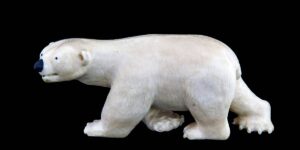A few words
About...
History
"It was love at first sight. ...
The intrinsic movement within the carvings and the variety of Material and artistic voices literally blew me away. …”
History
"It was love at first sight. ...
The intrinsic movement within the carvings and the variety of Material and artistic voices literally blew me away. ..."
History
"It was love at first sight. ...
The intrinsic movement within the carvings and the variety of Material and artistic voices literally blew me away. ..."
About InuitBeautiful.COM
The Joram Piatigorsky Collection
It’s exciting for me to see what started as an attraction, became a passion and developed over 35 years into a collection. In a way, it’s like raising a child and see the child develop into a successful, independent life of its own. It started like this:
Strolling along after a day’s skiing with my family in Vail I passed a gallery with beautifully shaped sculptures of green and black stones and caribou antlers and marine ivory and musk ox horns and whalebone in the window. The group dazzled me. What most caught my attention was the incredible movement inherent in the carvings. They weren’t standing still; they were alive. I went inside the gallery and didn’t know where to look first – it was like being surrounded by dozens of dancers in a theater I didn’t know existed. These weren’t souvenirs; they were fine art. I picked up a small bear carving. The store owner smiled. He saw immediately that by touching I connected with that little bear. In my hand, the bear melded with the artist. I think Helen Keller was right when she said that touch was the most important sense.
As I collected bit by bit and read about the Inuit and learned from my friend, John Burdick, who had one of the few Inuit galleries in the United States, I discovered that these magnificent works were far more than an aesthetic experience: they were an artistic microcosm filled with values both that I hold dear and that were new to me – about the centrality of family and cooperation, about playfulness and humor of daily life, about music, about ancient legends and myths that formed the foundation of Inuit culture, and about spirits and spiritual beliefs. Animals and humans were seen as an interacting continuum of body and soul, underlying mutual respect for one another. The many sculptures of shaman were chimeras of humans and animals, perhaps a bird with a human face or even a whale with caribou antlers, transformations of the shaman into the animal and back again, sharing their respective powers. This appealed to me as a scientist with an interest in evolution, for all animals are indeed our cousins, and the Inuit expressed this with skill, uncanny intuition and imagination in their art.
One of the most interesting aspects of Inuit art to me was its unexpected diversity, which all came from a homogeneous, frigid environment that’s dark for the much of the year. In this exhibition, the sculptures of the leap frog game and roaring bear and caribou are starkly realistic, the lonely Inuk with scratches for a face that appears at first sight no more than a small rock, the fanciful creatures as surrealistic as a Salvador Dali painting, the jet plane with a white pilot bombing bottles of alcohol on the Inuit and the angry Sedna portraying the dangers of global warning screaming lessons we should all heed. Each Inuit artist in the collection has a strong artistic voice that trumps the subject matter. In the same way that one can recognize a Van Gogh painting or Giacometti sculpture from afar – both household names among artists – one can recognize a Davidialuk or a Pangnark or a Talirunuili sculpture by style as well as subject.
I am deeply grateful for the opportunity to bring these wonderful Inuit artists to your attention, for they deserve to enrich your lives as they enriched mine.
More information about Inuit art can be found in my website blogs and books:
About InuitBeautiful.COM
The Joram Piatigorsky Collection
It’s exciting for me to see what started as an attraction, became a passion and developed over 35 years into a collection. In a way, it’s like raising a child and see the child develop into a successful, independent life of its own. It started like this:
Strolling along after a day’s skiing with my family in Vail I passed a gallery with beautifully shaped sculptures of green and black stones and caribou antlers and marine ivory and musk ox horns and whalebone in the window. The group dazzled me. What most caught my attention was the incredible movement inherent in the carvings. They weren’t standing still; they were alive. I went inside the gallery and didn’t know where to look first – it was like being surrounded by dozens of dancers in a theater I didn’t know existed. These weren’t souvenirs; they were fine art. I picked up a small bear carving. The store owner smiled. He saw immediately that by touching I connected with that little bear. In my hand, the bear melded with the artist. I think Helen Keller was right when she said that touch was the most important sense.

by Joe Talirunili
About InuitBeautiful.COM
The Joram Piatigorsky Collection
It’s exciting for me to see what started as an attraction, became a passion and developed over 35 years into a collection. In a way, it’s like raising a child and see the child develop into a successful, independent life of its own. It started like this:
Strolling along after a day’s skiing with my family in Vail I passed a gallery with beautifully shaped sculptures of green and black stones and caribou antlers and marine ivory and musk ox horns and whalebone in the window. The group dazzled me. What most caught my attention was the incredible movement inherent in the carvings. They weren’t standing still; they were alive. I went inside the gallery and didn’t know where to look first – it was like being surrounded by dozens of dancers in a theater I didn’t know existed. These weren’t souvenirs; they were fine art. I picked up a small bear carving. The store owner smiled. He saw immediately that by touching I connected with that little bear. In my hand, the bear melded with the artist. I think Helen Keller was right when she said that touch was the most important sense.

by Joe Talirunili

